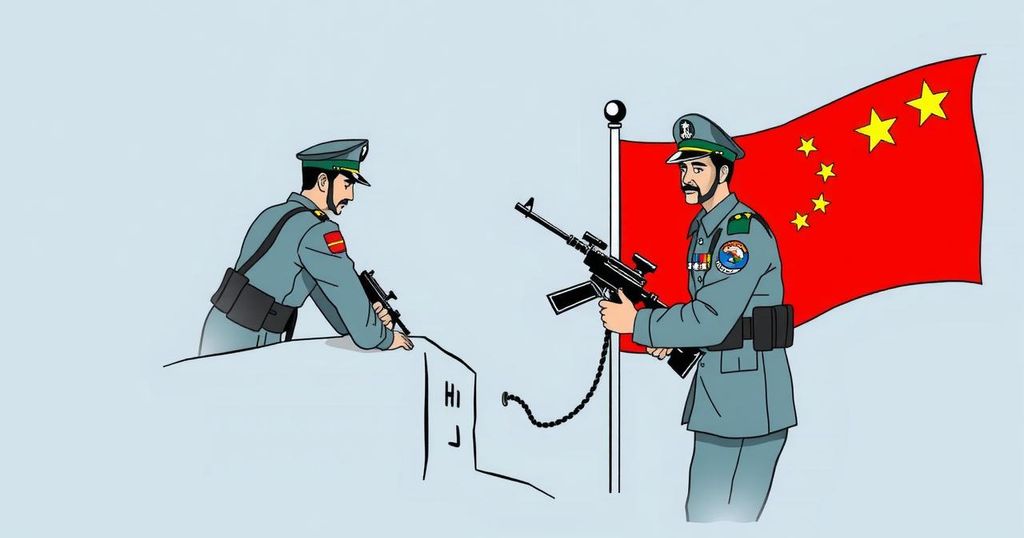Significance of the India-China Border Patrol Agreement
India and China have reached an important patrol agreement along the Line of Actual Control, aimed at reducing tensions and restoring peace post the 2020 Galwan clash. This arrangement is projected to ease military standoffs, build confidence, and promote higher-level diplomatic interactions, amid ongoing border disputes.
In a pivotal development four years after the skirmish in the Galwan Valley, India and China have agreed upon a new patrolling protocol along the Line of Actual Control (LAC). Foreign Secretary Vikram Misri revealed this initiative, emphasizing its potential to reduce tensions in the area. External Affairs Minister S. Jaishankar later expressed at the NDTV World Summit that this agreement would facilitate the patrolling practices reminiscent of the pre-2020 conditions, thereby fostering a more stable environment between the two nations. The importance of this agreement cannot be overstated. Firstly, it signifies a crucial step towards de-escalation in a region where both countries have amassed significant military presence. The restoration of previous patrolling norms diminishes the likelihood of confrontations that may arise from close military interactions. Furthermore, the agreement contributes to the stabilization of the LAC by mitigating the frequency of conflicts, particularly at contentious zones like Depsang Plains and Demchok. Such stability is indispensable for advancing broader discussions concerning boundary negotiations. Moreover, this renewed arrangement serves as a confidence-building measure, reflecting a mutual readiness from both India and China to revert to a status quo that was deemed acceptable prior to the recent tensions. This is expected to open channels for further dialogue between the two countries. The political ramifications of this agreement are also significant. It may pave the way for enhanced diplomatic engagements, including potential high-level meetings at international forums, thereby fostering better bilateral relations away from military disagreements. For India, this could facilitate the development of essential border infrastructure with diminished risks of conflict. Concurrently, China may view this agreement as a strategic decision to ensure stability along its border with India, especially against the backdrop of various other global tensions. The backdrop of this development is rooted in the Galwan Valley clash of June 15, 2020, which marked a severe escalation between Indian and Chinese forces along the LAC. This incident resulted in fatalities on both sides, with India reporting 20 soldier casualties amidst disputed figures regarding Chinese losses. The clash stemmed from border infrastructure conflicts and diverging perceptions of the LAC. Subsequent to this incident, both nations engaged in contingency talks, aiming for de-escalation amidst heightened bilateral tensions. In addition to Galwan, several other points of friction persist along the LAC, reflective of their historical disputes dating back to the 1962 war. Key areas include: – Demchok: The territory is divided by the LAC, with India controlling the western part while China governs the eastern region, leading to ongoing disputes over historical treaties and the LAC’s alignment. – Pangong: Ownership of approximately 50% rests with Tibet, while the remaining regions are contested, leading to military standoffs driven by differing LAC perceptions and ongoing strategic developments. – Hot Springs: The strategic significance of this area for India lies in its location, which enhances surveillance of the LAC, further contributing to India’s defensive capabilities. – Depsang: This region is vital for India as it facilitates access to critical logistics routes, enhancing military mobility and border defence strategies. Given these dynamics, the recent patrolling agreement signifies hopeful strides towards stability and mutual cooperation along the contentious India-China border.
The India-China border, specifically the Line of Actual Control, has been a site of conflict and strategic interest for decades. In June 2020, the Galwan Valley incident marked a significant escalation in hostilities, culminating in casualties for both sides and straining bilateral relations. The recent agreement to restore pre-2020 patrolling norms comes after years of diplomatic discussions aimed at de-escalating tensions, with numerous friction points along the LAC still remaining unresolved.
In summary, the newly established patrolling agreement between India and China represents a pivotal move towards de-escalation, stabilization, and confidence-building along their contentious border. It holds the promise of facilitating further diplomatic engagements while enhancing the prospects for a peaceful resolution to lingering disputes. This development is particularly significant given the complex backdrop of historical tensions, especially following the 2020 Galwan Valley clash, underscoring the importance of continued dialogue and cooperation between the two nations.
Original Source: www.ndtv.com








Post Comment